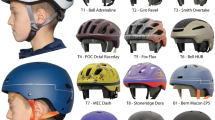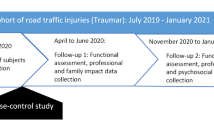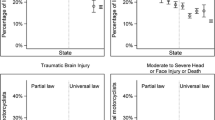Abstract
The results of a comparative study of the injury profiles of Victorian motorcyclist and bicyclist casualties were used by the Royal Australasian College of Surgeons in initiating a state-wide campaign to promote the wearing of approved safety helmets by Victorian bicyclists and to obtain the necessary legislation whereby such wearing would become compulsory. Bicyclist casualties had sustained more frequent and severe head injuries than motorcyclist casualties although the latter had sustained overall more severe body injuries. Increases in voluntary helmet wearing rates and reductions in costs preceded the introduction in July, 1990 in Victoria of compulsory safety helmet wearing by bicyclists. Sixty-four helmets obtained during a study of more than 1,700 Victorian bicyclists wearing and not wearing helmets were evaluated for performance by impact severity testing and findings related to head injury occurrence. Sixteen helmets sustained more than one impact during the accident. All casualties who sustained a severe head injury (Abbreviated Injury Scale ≥ 4) were involved in a collision with a motor vehicle and subjected to more than one impact to the head/helmet and/or the helmet had come off during the accident. Most impacts occurred below the current test lines of Australian and United States standards. Ten percent of impacts were more severe than required in performance standards. Recommendations are made for improvements in the current standard.
Résumé
Les résultats d'une étude comparative sur les types d'accidents concernant les motocyclistes et vélocyclistes dans la province de Victoria ont été utilisés par le Royal Australasian College of Surgeons pour faire une campagne nationale en faveur du port de caseque pour tout cycliste et obtenir des instances légales que le port du casque soit obligatoire. Les lésions crâniennes liés à un accident de vélo étaient bien plus fréquentes que celles liées à un accident de moto. Par contre, les accidents de moto provoquaient d'avantage d'accidents corporels sévères. Avant l'introduction en Juillet 1990 de l'obligation du port de casque dans la province de Victoria par les vélocyclistes, il y avait eu une augmentation du port volontaire du casque et par conséquent, une réduction des dépenses dans ce domaine. Parmi une population de plus de 1,700 cyclistes de la province de Victoria, 64 casques ont été choisis au hasard afin d'évaluer leur résistance à un choc et les possibles rapports avec la survenue d'accidents. On a trouvé que 16/64 casques avaient subi plus d'un choc pendant l'accident. Toutes les lésions crâniennes orrespendant à un score AIS de 4 ou plus étaient survenues lors d'un accident entre un cycliste et un véhicule motorisé. De plus, dans cette catégorie, la tête et le casque avaient reçu plus d'un choc et/ou le casque avait été perdu pendant le choc de l'accident. La plupart des chocs étaient inférieurs à la moyenne pour l'Australie et les Etats-Unis. Dix pourcent des chocs, cependant, étaient plus importants. Des recommandations sont proposées pour améliorer les normes des casques.
Resumen
Los resultados de un estudio comparativo de los perfiles de trauma de motociclistas del estado de Victoria (Australia) y de muertes de accidentes de bicicleta fueron utilizados por el royal Australasian College of Surgeons para iniciar una campaña estatal destinada a promover el uso de cascos de seguridad aprobados por los ciclistas victorianos y a lograr de la legislación necesaria para que su uso fuera obligatorio. Los muertos por accidentes de bicicleta habían sufrido más frecuentes y más severas lesiones craneoencefálicas que los muertos por accidentes de motocicleta, aunque los últimos habían sufrido, en general, más graves lesiones corporales. Se registraron incrementos en la frecuencia del uso voluntario de cascos y reducciones en los costos con anterioridad a la introducción en Victoria, en julio de 1990, de la obligatoriedad del uso de cascos por los ciclistas. Sesenta y cuatro cascos obtenidos en el curso del estudio sobre más de 1700 ciclistas victorianos que usaban y no usaban casco fueron evaluados en cuanto a la eficacia frente al impacto, y los hallazgos se correlacionaron con la incidencia del trauma craneano. Dieciseis cascos sufrieron más de un impacto en el accidente. Todos los muertos que sufrieron trauma craneano severo (AIS ≥ 4) estuvieron involucrados en una colisión con un vehículo automotor y sufrieron más de un impacto sobre la cabeza/casco y/o el casco se había soltado durante el accidente. La mayoría de los impactos se produjeron por debajo de los estándares de seguridad establecidos en Australia y en los E.U.A. Diez por ciento de los impactos fueron de mayor severidad que los requeridos en los estándares de referencia. Se hacen recomendaciones para mejorar los estándares actuales.
Similar content being viewed by others
References
Bouvier, R.: Bicycle accidents in childhood. Aust. Fam. Physician13:287, 1984
Guichon, D.M., Myles, S.Y.: Bicycle injuries: One year sample in Calgary. J. Trauma15:504, 1975.
Fife, D., Davis, J., Tate, L., Wells, J.K., Mohan, D., Williams, A.: Fatal injuries of bicyclists: The experience of Dade County, Florida. J. Trauma23:745, 1983
House of Representatives Standing Committee on Transport Safety: Bicycle Helmet Safety: Final Report on Motor Cycle and Bicycle Helmet Inquiry, Canberra, The Committee, 1, 1985
Australian Bureau of Statistics, Queensland Office: Road Traffic Amendments, 1983, Queensland, ABS, 12 July 1984, Catalogue No. 94043
Standards Association of Australia: General Purpose Protective Helmets (for Use in Pedal Cycling, Horse Riding, and other Activities Requiring Similar Protection), Sydney, Standards Australia, 1977
McDermott, F.T., Klug, G.L.: Differences in head injuries of pedal cyclists and motorcyclist casulaties in Victoria. Med. J. Aust.2:30, 1982
McDermott, F.T.: State action could cut child cyclists' injuries. Melbourne, The Age, November 17, 1983
Vulcan, A.P., Cameron, M.H., Watson, W.L.: Mandatory bicycle helmet use: The Victorian experience. World J. Surg.16:389–397, 1992
Wood, T., Milne P.: Head injurues to pedal cyclists and the promotion of helmet use in Victoria, Australia. Accid. Annal. Prev.20:177, 1988
McDermott, F.T.: Safety helmets for pedal cyclists: Leading article. Med. J. Aust.142:538, 1985
McDermott, F.T.: Helmets for bicyclists: Another first for Victoria: Leading article. Med. J. Aust.154:156, 1991
Social Development Committee, Parliament of Victoria: Final Report on Road Safety in Victoria, Melbourne, Government Printer, 1, October 1984
Sullivan, G., Wise, A.: Bicycle helmet usage rates in Victoria 1983–1990. Vic Roads, Report No. GR 90-9, 1990
Social Development Committee, Parliament of Victoria: Safe Road for Children “Inquiry into Child Pedestrian and Bicycle Safety”, Government Printer, September, 1987
McDermott, F.T., Klug, G.L.: Head injury predominance: Pedal cyclists vs motorcyclists. Med. J. Aust.143:232, 1985
McDermott, F.T., Klug, G.L.: Injury profile of pedal and motorcyclist casualities in Victoria. Aust. N.Z.J. Surg.55:477, 1985
The Abbreviated Injury Scale: 1985 Revision. Committee on Injury Scaling, American Association of Automotive Medicine, 1985
McLean, A.J., Brewer, N.S., Sandow, B.L.: Adelaide In-Depth Accident Study 1975–1979: Part 3: Pedal Cycle Accident, Adelaide, University of Adelaide, 1, 1979
Baker, S.P., O'Neill, B., Haddon, W. Jr., Long, W.B.: The injury severity score: A method for describing patients with multiple injuries and evaluating emergency care. J. Trauma.14:187, 1974
Waters, E.A.: Should pedal cyclists wear helmets? A comparison of head injuries sustained by pedal cyclists and motor cyclists in road traffic accidents. Injury17:372, 1986
Dorsch, M.M., Woodward, A.J., Somers, R.L.: Do bicycle safety helmets reduce severity of head injury in real crashes? Accid. Anal. Prev.19:184, 1987
Thompson, R.S., Rivara, F.P., Thompson, D.C.: A case-control study of the effectiveness of bicycle safety helmets. N. Engl. J. Med.320:1362, 1985
McDermott, F.T., Brazenor, G.A., Lane, J.C.: The Injury Profile of Bicyclist Casualties Wearing and Not Wearing Safety Helmets, Royal Australasian College of Surgeons, Monash University Department of Surgery, Alfred Hospital, Melbourne, 1991 (in press)
Williams, M.: Protective Performance of Bicyclists' Helmets in Accidents, Melbourne, Technisearch Limited, Royal Melbourne Institute of Technology, November, 1989
Williams, M.: The protective performance of bicyclists' helmets in accidents. Accid. Anal. Prev.23:119, 1991
A.S. Lightweight protective helmets (for use in pedal cycling, horse riding and other activities requiring similar protection): Part 2: Helmets for pedal cyclists AS 2063.2. Sydney, Standards Association of Australia, 1986
ANSI: American National Standard for Protective Headgear: For Bicyclists. ANSI-Z90.4, New York, National Standards Institute, 1984
Snell: 1984 Standard for Protective Headgear: For Use in Bicycling. Snell Memorial Foundation, 1984
Author information
Authors and Affiliations
Rights and permissions
About this article
Cite this article
McDermott, F.T. Helmet efficacy in the prevention of bicyclist head injuries: Royal australasian college of surgeons initiatives in the introduction of compulsory safety helmet wearing in Victoria, Australia. World J. Surg. 16, 379–383 (1992). https://doi.org/10.1007/BF02104435
Issue Date:
DOI: https://doi.org/10.1007/BF02104435




